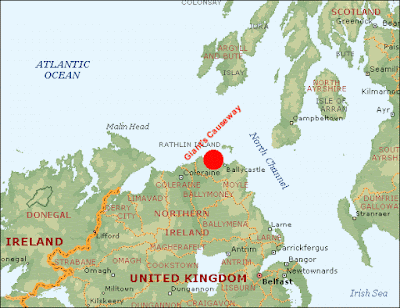Giant's Causeway, Northern Ireland
The Giant's Causeway is an area of about 40,000 interlocking basalt columns, the result of an ancient volcanic eruption. It is also known as Clochán an Aifir or Clochán na bhFomhórach in Irish and tha Giant's Causey in Ulster-Scots.
The Giant's Causeway,
renowned for its polygonal columns of layered basalt, is the only UNESCO World
Heritage Site in Northern Ireland and in 2015 was awarded the UKs Best Heritage
Attraction at the British Travel Awards.

Flora and Fauna
The area is a haven for seabirds such as fulmar, petrel, cormorant, shag, redshank, guillemot and razorbill, while the weathered rock formations host a number of
rare and unusual plants including sea spleenwort, hare's-foot trefoil, vernal squill, sea fescue and frog orchid
A stromatolite colony was
reportedly found at the Giants Causeway in October 2011 – an unusual find as
stromatolites are more commonly found in warmer waters with higher saline content
than that found at the causeway
The Giant’s Causeway is also
steeped in myth and legend. Some say it was carved from the coast by the mighty
giant, Finn McCool who left behind an ancient home full of folklore. Look out
for clues of his existence
For centuries countless
visitors have marvelled at the majesty and mystery of the Giants Causeway. At
the heart of one of Europe's most magnificent coastlines its unique rock
formations have, for millions of years, stood as a natural rampart against the
unbridled ferocity of Atlantic storms. The rugged symmetry of the columns never
fails to intrigue and inspire our visitors. To stroll on the Giants Causeway is
to voyage back in time.
Your imagination will travel along stepping
stones that lead to either the creative turbulence of a bygone volcanic age or
into the mists and legends of the past.
Location:
Coordinate: 55°14′27″N 6°30′42″W









No comments:
Post a Comment